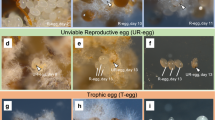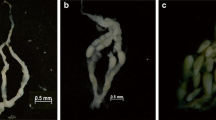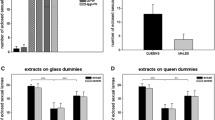Summary
Most matureMyrmica rubra, M. ruginodis, M. schencki andM. sulcinodis queens lay some trophic eggs in addition to reproductive eggs whether reared alone or attended by workers, and regardless of season. Queen trophic eggs resemble those laid by workers. They are oval, slightly flaccid, opalescent and contain no embryo, and inM. rubra andM. schencki they are significantly smaller than reproductive eggs. Generally, queens lay their first trophic eggs later in the season than their first reproductive eggs.
Similar content being viewed by others
References
Bailey, N. T. J., 1959.Statistical Methods in Biology. The English Universities Press, London. 200 pp.
Brian, M. V., 1983.Social Insects, Ecology and Behavioural Biology. Chapman and Hall, London. 377 pp.
Brian, M. V., R. M. Jones and J. C. Wardlaw, 1981. Quantitative aspects of queen control over reproduction in the antMyrmica.Ins. Soc. 28:191–207.
Brian, M. V. and C. Rigby, 1978. The trophic eggs ofMyrmica rubra L.Ins. Soc. 25:89–110.
Cammaerts, M.-C. and M. Scanu, 1985. Étude des facteurs expliquant la variabilité des groupements d'ouvrières deMyrmica rubra L. (Hymenoptera: Formicidae) autours de leurs reines.Annls. Soc. r. zool. Belg. 115:13–28.
Crespi, B. J., 1992. Cannibalism and trophic eggs in subsocial and eusocial insects. In:Cannibalism: ecology and evolution among diverse taxa (M. A. Elgar and B. J. Crespi Eds.), Oxford University Press, pp. 176–213.
Elmes, G. W., 1982. The phenology of five species ofMyrmica (Hym. Formicidae) from South Dorset, England.Ins. Soc. 29:548–559.
Elmes, G. W. and J. Petal, 1990. Queen number as an adaptable trait: Evidence from wild populations of two ant species (GenusMyrmica).J. Anim. Ecol. 59:675–690.
Hölldobler, B. and E. O. Wilson, 1990.The Ants. The Belknap Press of Harvard University Press, Cambridge, Mass., 732 pp.
Passera, L., 1978. Une nouvelle catégorie d'oeufs alimentaires émis par les reines vièrges dePheidole pallidula (Nyl.) (Formicidae, Myrmicinae).Ins. Soc. 25:117–126.
Smeeton, L., 1981. The source of males inMyrmica rubra L. (Hym. Formicidae).Ins. Soc. 28:263–278.
Taki, A., 1987. The trophic eggs of colony founding ant queens. In:Chemistry and Biology of Social Insects (J. Eder and H. Rembold Eds.), Verlag J. Peperny, München, p. 268.
Vargo, E. L. and K. G. Ross, 1989. Differential viability of eggs laid by queens in polygyne colonies of the fire ant,Solenopsis invicta.J. Insect Physiol. 35:587–278.
Wardlaw, J. C., 1991. Techniques for rearingMyrmica ants (Hym.) andMaculinea rebeli Hir. caterpillars (Lep., Lycaenidae).Ent. Mon. Mag. 127:233–241.
Weir, J. S., 1959. Egg masses and early larval growth inMyrmica.Ins. Soc. 6:187–201.
Author information
Authors and Affiliations
Rights and permissions
About this article
Cite this article
Wardlaw, J.C., Elmes, G.W. Trophic eggs laid by fertileMyrmica queens (Hymenoptera: Formicidae). Ins. Soc 42, 303–308 (1995). https://doi.org/10.1007/BF01240424
Received:
Revised:
Accepted:
Issue Date:
DOI: https://doi.org/10.1007/BF01240424




